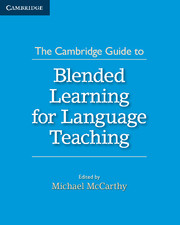Section 1 - Connecting Theories and Blended Learning
Published online by Cambridge University Press: 22 September 2021
Summary
A programme of blended learning can provide effective learning and teaching if built on a sound understanding of what constitutes best practice in language learning and teaching in general. Technology can support various learning environments and conditions if integrated seamlessly and in a way that allows pedagogy and technology to support one another smoothly. In this section of the book, we consider broader issues of language learning and teaching in relation to blended learning, considering what we know about language teaching and learning in conventional, face-to-face classrooms and exploring the questions this raises when language learning is transferred to the online and computermediated environment.
In Chapter 1, McCarthy considers the relevance to blended learning of certain key aspects of second language acquisition (SLA) and examines the question of which features of SLA can be conceived of as operating with equal, greater or lesser efficacy outside of the classroom in a computer-mediated and online environment. SLA not only focuses on strictly linguistic constraints but also recognises the role of psychological, social and cultural factors such as motivation, identity, individual styles and abilities and the effectivity of learning strategies, noticing and the value of feedback. The chapter seeks to lay out the territory for a consideration of how blended learning might be conducted if informed by key concepts in SLA. McCarthy focuses on some of the more challenging insights of SLA, for example, the importance of noticing, the importance of enhanced input, the role of motivation and attitudes and individual differences in language learning. None of these provides straightforward recipes or simple solutions for blended learning, but all should be in the minds of curriculum and materials designers when embarking upon blended programmes and entering into the delicate decisions that have to be made as regards the distribution of resources and activities. McCarthy also stresses the central significance of what happens in typical face-to-face classrooms, where moment-by-moment interaction is skilfully steered by expert, sensitive teachers, and how this mirrors the interactive world outside of the classroom, as evidenced in language corpora. The chapter concludes that some of the less mechanical aspects of language learning may well be replicable in the world of social media, while success in blended learning programmes will undoubtedly depend on collaboration between technology experts and educators, with neither alone holding the key to success.
Information
- Type
- Chapter
- Information
- Publisher: Cambridge University PressPrint publication year: 2015
